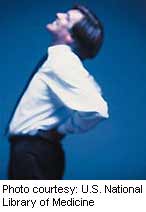
MONDAY, Oct. 1 (HealthDay News) — Experts have developed evidence-based guidelines to help doctors manage patients with acute low back pain.
Low back pain is one of the most common reasons for outpatient visits to doctors, but there is a lack of consistency in how best to handle these cases, according to the team that developed the guidelines, which were published in the October issue of the Journal of the American College of Radiology.
“The approach to the workup and management of low back pain by physicians and other practitioners is inconstant,” article co-author Dr. Scott Forseen said in a journal news release. “There is significant variability in the diagnostic workup of back pain among physicians within and between specialties.”
He and his colleagues at Emory University Hospital and Georgia Health Sciences University developed a process for how doctors should manage patients with low back pain.
During their first visit, patients should be categorized into one of three groups after a thorough medical history and physical examination: non-specific low back pain; low back pain potentially associated with compression of a nerve in the spine (radiculopathy) or abnormal narrowing of the spinal canal (spinal stenosis); or low back pain potentially associated with a specific cause.
The guidelines also provide evidence-based information for each category of patient to guide doctors through the process of evaluation, management and follow-up of patients, including recommendations for appropriate imaging and laboratory tests and referral for consultation about surgery or other procedures.
“We have presented a logical method of choosing, developing and implementing clinical decision support interventions that is based on the best available evidence,” Forseen said. “These templates may be reasonably expected to improve patient care, decrease inappropriate imaging utilization, reduce the inappropriate use of steroids and narcotics, and potentially decrease the number of inappropriate invasive procedures.”
More information
The U.S. National Institute of Neurological Disorders and Stroke has more about low back pain.

